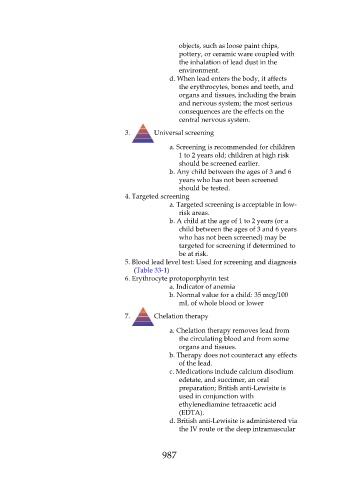Page 987 - Saunders Comprehensive Review For NCLEX-RN
P. 987
objects, such as loose paint chips,
pottery, or ceramic ware coupled with
the inhalation of lead dust in the
environment.
d. When lead enters the body, it affects
the erythrocytes, bones and teeth, and
organs and tissues, including the brain
and nervous system; the most serious
consequences are the effects on the
central nervous system.
3. Universal screening
a. Screening is recommended for children
1 to 2 years old; children at high risk
should be screened earlier.
b. Any child between the ages of 3 and 6
years who has not been screened
should be tested.
4. Targeted screening
a. Targeted screening is acceptable in low-
risk areas.
b. A child at the age of 1 to 2 years (or a
child between the ages of 3 and 6 years
who has not been screened) may be
targeted for screening if determined to
be at risk.
5. Blood lead level test: Used for screening and diagnosis
(Table 33-1)
6. Erythrocyte protoporphyrin test
a. Indicator of anemia
b. Normal value for a child: 35 mcg/100
mL of whole blood or lower
7. Chelation therapy
a. Chelation therapy removes lead from
the circulating blood and from some
organs and tissues.
b. Therapy does not counteract any effects
of the lead.
c. Medications include calcium disodium
edetate, and succimer, an oral
preparation; British anti-Lewisite is
used in conjunction with
ethylenediamine tetraacetic acid
(EDTA).
d. British anti-Lewisite is administered via
the IV route or the deep intramuscular
987

